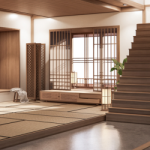What is interior design? Interior design is the art of enhancing interiors to create functional, visually appealing spaces. It focuses on optimizing spaces to suit specific needs while harmonizing aesthetics and functionality.
In this blog, discover the interior design description. Explore its varied types, understand its significance, delve into its scope in India, and uncover the best interior design courses & landscape of interior design salaries in 2023.
Join us for an exploration into the multifaceted world of interior design, encompassing its diverse dimensions and evolving landscape within the Indian context.
Table of content
What is Interior Design?
Types of Interior Design
Importance of Interior Design
Scope of Interior Design in India
Interior Design Salary in India in 2023
What is Interior Design Course
What is Interior Design?
Interior Design Description: Interior design involves the artful arrangement and transformation of interiors, emphasizing elements like furniture, color schemes, spatial organization, and décor to create harmonious and functional spaces.
An interior designer is a skilled professional responsible for conceptualizing, planning, and executing designs that enhance and optimize interior spaces. They possess a deep understanding of architectural principles, spatial arrangements, aesthetics, and functionality to create environments that cater to clients’ needs and preferences.
These professionals collaborate closely with clients to understand their vision, preferences, and requirements for the space. They utilize their creative flair and technical expertise to design layouts, select suitable color schemes, furniture, materials, and accessories that harmonize with the architectural elements of the space.
Interior designers are adept at creating functional, visually appealing spaces by considering aspects such as lighting, acoustics, ergonomics, and sustainability. Their work spans a wide spectrum, encompassing residential, commercial, hospitality, and institutional spaces, and involves creating designs that reflect the client’s personality or brand identity while ensuring a seamless blend of aesthetics and practicality.
Types of Interior Design
When exploring the realm of interior design, various specialized types of interior designs and themes emerge, each catering to distinct preferences and functions. Here are some different types of interior designs:
- Residential Interior Design: This type focuses on creating personalized living spaces, including apartments, houses, and villas. It involves designing functional yet aesthetically pleasing interiors that align with the homeowners’ tastes and lifestyle.
- Commercial Interior Design: Addressing business spaces such as offices, retail stores, and restaurants, commercial interior design emphasizes functionality, branding, and customer experience. It aims to optimize the space for productivity, sales, or customer engagement.
- Hospitality Interior Design: This specialty revolves around hotels, resorts, and hospitality venues. It aims to create inviting, comfortable, and luxurious spaces that evoke a specific ambiance and offer a memorable experience to guests.
- Institutional Interior Design: Educational institutions, healthcare facilities, and public spaces fall under this category. The focus is on creating conducive environments that support learning, healing, or public interaction, considering safety, accessibility, and functionality.
- Themes in Interior Design: There are different types of themes in interior design encompassing various styles like minimalism, vintage, contemporary, or eclectic. These themes guide the overall aesthetics, color palettes, furniture choices, and décor elements, reflecting specific design philosophies or eras.
Importance of Interior Design
Interior design plays a pivotal role in shaping environments to meet functional and aesthetic needs. It focuses on optimizing spaces, considering elements such as layout, color, lighting, and furniture arrangement to create harmonious and functional settings.
Interior design plays a pivotal role in shaping environments to meet functional and aesthetic needs. The importance of interior design lies in its ability to transform spaces into places that align with the occupants’ requirements and desires. It focuses on optimizing spaces, considering elements such as layout, color, lighting, and furniture arrangement to create harmonious and functional settings.
By amalgamating practicality with aesthetics, interior design ensures that spaces not only look appealing but also serve their intended purposes effectively. Its role extends across various sectors, influencing how people interact with and experience spaces, whether residential, commercial, hospitality, or institutional. Thus, interior design remains instrumental in curating environments that are both visually captivating and functionally efficient.
Scope of Interior Design in India
The diversity in types of interior design showcases the multifaceted nature of the field, allowing professionals to specialize in areas that align with their interests, skills, and the evolving needs of clients and industries.
The scope of interior design in India encompasses a broad spectrum of opportunities across various sectors and specialties:
- Residential Design: The demand for personalized and aesthetically pleasing homes is on the rise. Interior designers specialize in creating functional, beautiful, and customized interiors for individual residences, apartments, villas, and penthouses.
- Commercial Design: Offices, retail spaces, restaurants, and corporate setups require innovative interior designs that reflect the brand’s identity and enhance customer experience. This sector offers opportunities for designers to create workspaces that foster productivity and commercial areas that attract clientele.
- Hospitality Sector: Hotels, resorts, cafes, and entertainment venues rely heavily on interior design to create immersive and memorable experiences for guests. Designers in this sector focus on creating ambiance, luxury, and comfort while aligning with the brand’s vision.
- Institutional Spaces: Educational institutions, healthcare facilities, and public spaces increasingly value well-designed interiors that facilitate learning, healing, and public engagement. Interior designers ensure functionality, safety, and aesthetics within these environments.
- Sustainable Design: With a growing emphasis on sustainability, interior designers are exploring eco-friendly materials, renewable resources, and energy-efficient solutions. Sustainable design practices are gaining momentum, offering a specialized niche within the field.
- Furniture and Product Design: Some interior designers extend their expertise into creating custom furniture, lighting fixtures, and decor items. This aspect involves designing products that complement interior spaces and cater to specific client needs.
The evolving urban landscape, changing consumer preferences, and a heightened focus on aesthetics and functionality contribute to the vast and ever-growing scope of interior design in India. This dynamic field offers numerous avenues for professionals to explore and innovate, creating spaces that seamlessly blend creativity, functionality, and beauty.
Interior Design Salary in India in 2023
In India, the salary for interior designers in 2023 varies based on factors such as experience, qualifications, and the type of projects undertaken:
- Entry-Level Salary: Fresh interior design graduates can expect an average annual salary ranging from INR 3.5 lakhs to 6 lakhs. This initial salary level usually applies to those starting their careers or working on smaller projects.
- Mid-Level Salary: Interior designers with around 3-5 years of experience can earn an average annual salary between INR 6 lakhs to 10 lakhs. With this experience, they often handle moderately sized projects or work within established design firms.
- Senior-Level Salary: Seasoned interior designers with 8-10 years or more of experience, along with a successful portfolio, can command higher salaries ranging from INR 12 lakhs to 20 lakhs or more annually. At this level, designers often manage larger projects, have their firms, or hold prestigious positions in established design companies.
- Location Influence: Salaries can also vary based on the city. For instance, interior designers in metropolitan areas like Mumbai, Delhi, or Bangalore might generally earn higher compared to those in smaller cities or towns due to cost of living differences and the demand for design services in these urban hubs.
- Independent Designers: Those working independently may have fluctuating incomes based on the number and scale of projects undertaken. Some may earn between INR 50,000 to 1 lakh per month or higher based on project fees and client base.
Overall, the interior design industry in India offers a wide salary spectrum, allowing professionals to grow their earnings with experience, skill development, and successful project portfolios.
What is Interior Design Course
Interior design courses offer comprehensive education in spatial planning, design principles, material selection, and project management within various built environments. These courses focus on fostering creativity, technical skills, and an understanding of aesthetic elements to create functional and visually appealing interiors. Understanding what interior design is in depth is the main focus of these courses.
Interior Design Courses in 2023
In 2023, the field of interior design offers diverse educational courses catering to aspiring designers, including:
Bachelor’s Degree in Interior Design: Several universities and design institutes across India offer comprehensive four-year undergraduate programs focusing on various aspects of interior design, covering fundamentals, design principles, and practical applications.
Master’s Degree in Interior Design: Postgraduate programs provide advanced education and specialization in interior design, allowing students to delve deeper into specific areas such as sustainable design, furniture design, or spatial planning.
Diploma/Certificate Courses: Short-term diploma or certificate courses, often spanning 6 months to a year, provide focused training on specific aspects of interior design, ideal for individuals seeking practical skills in a shorter duration.
Online Courses: Various online platforms offer interior design courses, providing flexibility for remote learning and self-paced study options. AAFT Online’s 1-year Diploma in Interior Design is one such program that emphasizes a comprehensive understanding of design principles and practical applications through an online learning platform.
Conclusion
In conclusion, the essence of interior design lies in its ability to transform spaces into engaging and functional environments. By orchestrating the fusion of form and function, interior designers craft spaces that cater to the specific needs, preferences, and aspirations of individuals or organizations. We hope this overview has provided a clearer understanding of the intricacies and significance of what interior design truly embodies. To know more about what is interior design visit AAFT Online.






























